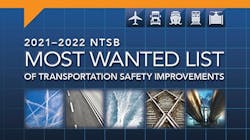NTSB unveils 2021-2022 Most Wanted safety list
The National Transportation Safety Board (NTSB) unveiled its biennial Most Wanted List of Transportation Safety Improvements on April 6 following a vote by the NTSB’s five-member board. The list is a compilation of recommendations designed to address safety challenges in aviation, highway, marine, rail and pipeline transport.
NTSB published its first Most Wanted list in 1990 and transitioned the list from an annual announcement to a biennial one with its 2017-2018 list to allow the transportation industry additional time to implement meaningful changes that would positively impact the safety recommendations.
New to this year’s list is a more mode-specific focus versus past lists, which featured 10 broad, multi-modal safety issues tied to hundreds of NTSB recommendations. While the items included on this edition of the Most Wanted List involve 100 safety recommendations, NTSB explains that should these recommendations be implemented, they have the potential to save lives, reduce the number and severity of injuries and prevent accidents.
The 2021-2022 Most Wanted List of Transportation Safety Improvements includes:
- Aviation: Require and Verify the Effectiveness of Safety Management Systems in all Revenue Passenger-Carrying Aviation Operations
- Aviation: Install Crash Resistant Recorders and Establish Flight Data Monitoring Programs
- Highway: Prevent Alcohol and other Drug Impaired Driving
- Highway: Require Collision Avoidance and Connected Vehicle Technologies on All Vehicles
- Highway: Eliminate Distracted Driving
- Highway: Implement a Comprehensive Strategy to Eliminate Speeding-Related Crashes
- Highway: Protect Vulnerable Road Users through a Safe System Approach
- Rail, Pipeline and Hazardous Materials: Improve Pipeline Leak Detection and Mitigation
- Rail, Pipeline and Hazardous Materials: Improve Rail Worker Safety
- Marine: Improve Passenger and Fishing Vessel Safety
“Board members of the NTSB and our advocacy team continuously seek opportunities to communicate about items on our Most Wanted List,” said NTSB Chairman Robert Sumwalt. “As we begin advocacy efforts for the 2021 – 2022 MWL, we call upon our advocacy partners to amplify our safety messages and help us bring about the safety improvements that will make transportation safer for us all.
Just as important as what is included in the list is what is not on the list. Positive Train Control (PTC) first appeared on the Most Wanted List in 2001 and was included in some form through most iterations of the list until the 2021-2022 list. The technology offers an extra element of safety to control train movements and prevents certain train accidents from occurring. The U.S. rail industry was required by law to have the technology installed by Dec. 31, 2020. Two days before that deadline, Dec. 29, the Federal Railroad Administration said PTC was in operation on all required freight and passenger railroad route miles.
The American Public Transportation Association (APTA) released a statement noting its appreciation of NTSB removing the safety recommendation from its Most Wanted List.
“After commuter rail agencies invested more than $4 billion to implement PTC, they successfully met the statutory deadline of Dec. 31, 2020, for full PTC implementation. In addition to the $4 billion implementation cost, commuter rail operators will spend more than $100 million each year to maintain and operate the PTC system,” said APTA President and CEO Paul Skoutelas. “Industry-wide implementation of PTC has been a massive undertaking, achieved only through dedication and innovation by commuter rail operators along with PTC equipment providers, consultants and the Federal Railroad Administration. Technological systems needed to be developed, customized and installed to meet the unique operating requirements of each and every rail operator while ensuring that the PTC system was interoperable with other passenger and freight operators that share the tracks with commuter rail operators. Riding commuter rail is 18 times safer than driving an auto and the commuter railroad’s monumental achievement of PTC certification will make commuter rail service even safer.”
Four of NTSB’s current Most Wanted List items could have impacts on the transit industry including the call to Protec Vulnerable Road Users through a Safety System Approach; Require Collision-Avoidance and Connected-Vehicle Technologies on all Vehicles; Improve Passenger and Fishing Vessel Safety; and Improve Rail Worker Safety.
NTSB says it will continue to work on specific recommendations for each of the items included on the Most Wanted List.
About the Author

Mischa Wanek-Libman
Group Editorial Director
Mischa Wanek-Libman is director of communications with Transdev North America. She has more than 20 years of experience working in the transportation industry covering construction projects, engineering challenges, transit and rail operations and best practices.
Wanek-Libman has held top editorial positions at freight rail and public transportation business-to-business publications including as editor-in-chief and editorial director of Mass Transit from 2018-2024. She has been recognized for editorial excellence through her individual work, as well as for collaborative content.
She is an active member of the American Public Transportation Association's Marketing and Communications Committee and served 14 years as a Board Observer on the National Railroad Construction and Maintenance Association (NRC) Board of Directors.
She is a graduate of Drake University in Des Moines, Iowa, where she earned a Bachelor of Arts degree in Journalism and Mass Communication.
